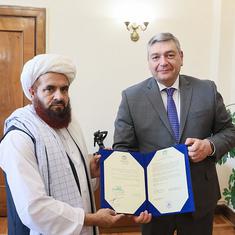There are two stories unfolding in the WTA Tour presently. One is that that the 23-time Grand Slam champion, and world No 1, Serena Williams is unwinding – and regrouping ahead of the Tour’s lengthy American stopovers in Indian Wells and Miami. And the other that in her absence, the state of women’s tennis has entered a state of flux with contenders abounding and dropping off simultaneously.
This past week, thanks to her breezy run in Doha, it seems to be Karolina Pliskova’s turn to be the player expected to up the ante of her game and take it to the next level. Not that there’s any misgiving about the Czech’s potential, the first sign of which came at the 2016 Cincinnati Open when she defeated Angelique Kerber in the final.
Trying to gauge the extent of her consistency on the court but comes with an underlying worry that she, too, will fall short to patchiness of form – as evidenced in Dubai – thereby adding her name to the mix of countless other players, who have had a similarly futile outing. In failing to exceed expectations, but to also emerge as a challenger to Williams’s near-monopolistic dominion.
UPSET ALERT: Kristina Mladenovic about to serve for the match at 6-2, 5-4 against No2 seed and Doha champ Karolina Pliskova
— Reem Abulleil (@ReemAbulleil) February 21, 2017
Seed No2 Karolina Pliskova joins No3 and No5 out of the tournament 6-2, 6-4 to Kristina Mladenovic #DDFtennis
— Reem Abulleil (@ReemAbulleil) February 21, 2017
The broken-yet-uninterrupted reign of Serena Williams
Williams’s seventh Australian Open title, over sister and long-time rival, Venus, settled the Greatest of All Time (GOAT) debate in the sport for good. Hers was then not a short-term appropriation of the term, but went on to connote longevity the likes of which needed to be displaced in equally absolute terms. The latter, thus, brings the subject round to the aspect of rivals – or the stultifying lack thereof – Williams has had to encounter en route to establishing herself as tennis’ best.
With the sole exception of Pliskova, against whom she has a break-even head-to-head, the 35-year-old has a widened margin of leads in her matchups against the remaining eight players in the top-10 ranking. The sizeable nature of this discrepancy then gets compounded by the fact that there are only three other players in the top-10 – Svetlana Kuznetsova, Garbine Muguruza and Kerber – who have won a Major apart from Williams and that their numbers only make up for less than the entirety of Williams’s tally.
Petty and unbecoming as it would then be to pose a detraction from Williams’s accomplishments because of such skewed statistical topography, it also presents quite a delineating picture of the women’s side of the game, as compared to the years before.
Nemeses, who stopped time
In the recurring theme of describing of tennis’s avidly followed rivalries, especially of those belonging in the not-so distant past, there have been a few that went on to set a distinct tonality of perception.
There was the singularity of Chris Evert-Martina Navratilova chapter that pitted them as rivalling opponents in singles, an impenetrable team in doubles and friends off the court, and the tragedy-struck verse of Monica Seles and Steffi Graf. There have also been the historic sibling face-offs between Venus and Serena, renewed for the 28th time in Melbourne Park in January. Each of these rivalries always had – in the sisters’ case, still has – one opponent spurring on the other to bring out her best, as if each were an inadvertent catalyst for the other.
The one-sided shift in the results, in favour of any player, then also came to be the defining and intertwined attributes of their competitiveness as much as they denoted the core breakdown of how each stacked up against the other, irrespective of the passage of time.
Serena Williams: A tale of contrasting stand-alone
That Serena Williams doesn’t have such a notable rivalry to speak of, barring her sister, makes for a stark appeal, most specifically for the future – years down the line. For, while talking about her lengthily sustained peak, there would be no reference of a fitting counterpoint as there’s no clarity whatsoever on one particular rival to narrow down.
Do we mention Maria Sharapova who, despite starting off her career against the American with wins in 2004, couldn’t add much to her initial successes, a dozen years onward? Or do we describe how close Martina Hingis came to overturning Williams’s advantageous form against her, all the while knowing that it would be an unmatched comparison at best, what with the Swiss long bowing out of the singles realm. Perhaps, we would do well to make a specific notation to Victoria Azarenka who, despite her transience in her performances against Williams, remained a tricky player for her to best.
With Kerber, the last player to keep up with Williams, also starting to slip, there doesn’t seem to be immediate truncation of this quirky lopsidedness surrounding the Florida resident’s professional timeline. As such, while she will be etched as a definitive stand-alone in the annals of tennis’ history, Serena Williams also looks to stand alone as peerless, in an ironic twist to its literalness.










